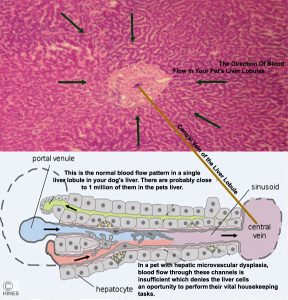Hepatic Microvascular Dysplasia In Your Dog
aka: Portal Vein Hypoplasia PVH-MVD Portal Vein Atresia
Ron Hines DVM PhD
 Some newer liver disease medications
Some newer liver disease medications
 Portosystemic Shunts In Your Dog
Portosystemic Shunts In Your Dog
Hepatic microvascular dysplasia is primarily a problem seen in little breeds of dogs – the dependent ones that love to cuddle and love to be spoiled. Like all breeds of dogs, they were created by breeding for a special talent, a special appearance or a special size. Some veterinarians suspect that in the quest for tiny dogs, breeders inadvertently picked some that were small for reasons that were not, at first sight, apparent. One was an inability to process nutrients properly as they were carried through the dog’s blood stream from their intestines to their liver. (read here)
Liver architecture is designed so that nutrient-rich blood arriving from the intestines efficiently bathes each individual liver cell (hepatocyte). You can see that architecture if you click on the diagram below:
Hepatocytes make up about 80% of your dog’s liver. These cells are arranged into circular structures (lobules) with numerous blood channels (sinusoidal spaces) separating long lines (cords) of liver cells – much like supermarket aisles separate the lines of products and produce. For hepatocytes to perform their diversified functions, those blood channels need to receive, at their outer lobule (island) borders, blood from the intestine that is rich in recently absorbed nutrients. Hepatocytes also need this tremendous blood flow to cleanse the body of toxins. (read here) This nutrient-rich blood is delivered to the liver through the portal vein that drains blood arriving from their intestines. Liver cells (hepatocytes) also need a lot of oxygen because of the high metabolic demands required to accomplish their many chores. That blood comes to them from the lungs through their hepatic artery. When the amount of fresh blood bathing them is insufficient, liver cells cannot maintain body health.
By the time blood percolates to the center of each liver lobule, healthy hepatocytes have detoxified unwanted products that were absorbed through the intestine, synthesized a number of blood proteins, produced fatty acids from the carbohydrates in the pet’s diet, converted waste ammonia into urea, synthesized cholesterol and bile salts and stored sugar (glucose) from the blood in the form of glycogen.
Critical to the liver’s success in doing all that is a proper flow of blood bathing each individual hepatocyte. In MVD, blood does not percolate around the hepatocytes as it should. Instead, the blood delivering nutrient and toxin rich blood from the dog’s intestines shortcuts around (bypasses) the hepatocyte cords and enters the pet’s general circulation directly. So whereas portosystemic shunts do the same thing through large, visible shortcut channel(s), MVD does a similar thing through a multitude of tiny abnormal channels present in your dog’s liver at the microscopic level. Too much blood is bypassing your pet’s important liver roles.
Some veterinarians refer to MVD as “liver shunts” – lumping them together with the larger portosystemic shunts that are visible to the naked eye. I tend to reserve that term “shunts” for abnormal channels big enough to show up on a doppler ultrasound examination. (see here) But when the two are lumped together, they are often called “portosystemic vascular anomalies” (PSVA).
Toy and small breeds (e.g. Yorkshire terriers, Maltese, Shih Tzu, Border Terriers, Cairn Terriers, Havanese, Miniature Schnauzers, Norfolk Terriers, Papillon, Pugs, Smooth Fox Terriers and Tibetan Spaniels) seem particularly susceptible to genetically-based Hepatic Microvascular Dysplasia or MVD. Us humans are occasionally born with liver blood flow defects too. (read here) In people these diseases are quite rare (~ <1/8,000 births).
Stopped link check in post view here
Most Dogs That Carry The MVD Trait Lead Healthy Happy Lives
Dogs that carry the MVD trait tend to be a bit smaller than their littermates, but only a few will develop health issues because of it. But when health issues do develop in your dog, they can begin at any time during its life. All degrees of MVD/PVH exist. The most seriously affected individuals are often picky eaters. (read here) The most seriously affected might be the ones that die shortly after birth or lived long enough to be considered “fading puppies”. Their demise (death) might have been attributed to (blamed on) other causes such as parental neglect. On x-rays or tummy palpation, your veterinarian might describe the liver of a severely affected pet to you as being smaller than it should be (=hypoplastic, shriveled, atrophied, shrunken, underdeveloped or liver atresia). An ultrasound examination would confirm that.
The same bile acids test used to help diagnose portosystemic shunts is used to diagnose MVD/PVH. To tell which it is, vets rely on the absence of visible shunts during a doppler ultrasound exam to rule out PSS and a liver biopsy to confirm MVD/PVH. Occasionally, both issues are present. Of course, the fact that your dog is one of the toy breeds makes an MVD diagnosis all the more likely.
Veterinarians currently have no surgical treatment to cure MVD/PVH and no medications that can reverse it. The many “cures” you see sold on the internet are all fraudulent; I believe that the “liver support” products run a close second when it comes to their lack of benefits. But since treatment options for dogs with MVD are so few, go ahead and try them anyway. If your dog’s after-meal bile acid level goes down on one of these products, so much the better.
When pets do experience health issue due to microvascular dysplasia or similar portal vein blood delivery problems, veterinarians tend to focus on abnormally high a blood ammonia level as the probable cause. You see, one of the jobs of your dog’s liver is to convert toxic waste ammonia (a normal byproduct of metabolism) into less toxic urea. A higher than normal blood ammonia level is thought to be responsible (at least in part) for the mental issues many dogs with severe liver issues face. Those mental issues are called hepatic encephalopathy.
However, it is not as simple as high ammonia. Blood ammonia levels have not correlated well with the degree of mental issues an individual pet is experiencing. Perhaps the elevated bile acid levels also found in these pets play a part in their mental issues as well. Some vets theorize that other unknown toxins that accumulate in MVD cause alterations in blood amino acids and, perhaps, changes in the brain itself. We really do not know. Much of a veterinarian’s knowledge trickles down from research aimed a treating human disease. A person facing severe liver issues would most likely be offered a liver transplant.
I want to emphasize again that most dogs with MVD/PVH NEVER develop hepatic encephalopathy.
What Signs Might I See If My Pet Has MVD?
Your pet might have been born smaller than its littermates.
It is probably a finicky eater.
It might have bouts of diarrhea and vomiting without a satisfactory explanation.
It might occasionally have seizures or fainting episodes (perhaps due to hypoglycemia) or periods of mental dullness – some call it moodiness.
It might have abnormally intense reactions to drugs that are normally detoxified or removed from its body by its liver. It might also have an unusually extended or profound reaction to tranquilizers and sedatives.
A thin hair coat is not uncommon.
A pet with MVD might have periodic UTIs (this situation is quite rare in MVD, but when it does occur, it is actually due to ammonium biurate crystals in its urinary tract).
A MVD problem might also have been mistaken for inflammatory bowel disease (IBD) or a dog might face both issues.
All of the symptoms I listed could be due to something entirely different than MVD – even if it documented that your pet carries the MVD/PVH trait. One might confuse the signs of a finicky eater that is just spoiled or has dental problems, epilepsy, toy breed hypoglycemia, hydrocephalus, inflammatory bowel disease, or simply behavioral issues with hepatic microvascular dysplasia.
How Will My Veterinarian Decide?
The most important screening test for MVD/PVH is a blood bile acids test. High blood bile acids levels are a sign of liver problems. The bile acid test is not foolproof – it will occasionally miss a mild case. The tests are done – one before a meal (=preprandial) after a night’s fast and one after a meal (=postprandial). Generally, it is the postprandial test that is the highest – but not always. In any case, any reading above 15-20 micromoles/Liter in a high-incidence breed is suspicious for MVD when the typical symptoms are present (other liver diseases can sometimes elevate the readings as well). The test can be run on kittens and puppies as young as 8 weeks old; but it should be confirmed again about 8 weeks later.
Periodic bile acid tests are not a particularly accurate way to monitor how well your pet’s liver is working over the years. You see, the values vary greatly from day to day – even hour to hour. Of course, very large increases over time are worrisome. Keeping a log of your pet’s body weight, attitude and energy level along with periodic general blood chemistry screens are a more accurate measure of your pet’s overall health (blood albumin level, BUN, creatinine, and glucose, liver enzymes and perhaps C-reactive protein).
Blood bile acid levels are usually also high in portosystemic shunts. A doppler ultrasound exam should be able to rule those large (and often correctable) shunts out. The next confirmatory MVD tests are usually liver biopsies from multiple locations in your pet’s liver. That can identify the liver changes that point to MVD. The biopsies might also be able to judge the severity of the problem. If the changes are mild but the symptoms severe, perhaps some of the other diseases with similar signs I mentioned early need to be ruled out. Some advanced facilities rely on trans-splenic scintigraphy – a procedure that utilizes radioactive markers to trace blood flow. Short of biopsies, diagnosing MVD beyond a doubt can be very difficult. Veterinarians just don’t have a blood test that rules the disease in or out reliably.
How Can I Manage This Problem When My Pet Is Showing Symptoms?
Diet
We know that dogs with MVD/PVH have problems processing the protein they absorb from their meals. So, for a long time, veterinarians suggested that the amount of protein that MVD dogs received be restricted. Similar advice was given to humans whose livers had been damaged by cirrhosis and other diseases. However, over time, human physicians found that their patients with liver problems actually needed more protein, not less. Their patients had a tendency to lose weight due to their poor appetite and metabolic difficulties and protein restriction only made matters worse.
Following that lead, pet food manufacturers like Hills and Royal Canin increased the protein content of their “liver support” diets and marketed them based on their low copper level (only helpful in much rarer copper storage disease, not MVD/PVH) a “precise blend of antioxidants to support a healthy immune systems” and increased flavor and density to tempt picky eaters”. All fine and good. But I have never understood why a pet owner should need a prescription to feed their pets high-quality ingredients.
It is fine for you to feed your dog those diets if you wish. We all need to feel we are doing everything that we can for the ones we love. However, there is really no scientific evidence that they will be any more helpful than a high-quality dog food brand. If, on the other hand, your dog lives on table scraps, those prescription diets are considerably better balanced than what most toy breeds choose to eat when given the chance. They want to eat the meat you eat and, preferably, a place at the table. (see here) What is much more important is that you feed your pet many very small meals throughout the day to keep its liver workload down rather than only a few larger meals. Some suggest that plant and dairy proteins might be more advisable than meat proteins. I do not know on what evidence that is based, but balanced plant protein diets are available and they might be worth a try. (see here)
Probiotics
Some veterinarians suggest probiotics or yogurt for its bacterial content. There is certainly no harm in giving your dog some Greek yogurt in moderation – if it agrees with your pet (dogs vary on the amount of dairy lactose that gives them flatulence and diarrhea). But just like optimal protein content, we just do not know if probiotics have any positive influence on liver function or lessen any of the unwanted metabolic waste products that might overwhelm a dog’s poorly functioning liver. If you take them yourself, give some to your dog as well. I do suggest them – or much better yet – a fecal transplant, if your dog has been on long-term antibiotics. The simplest way to perform a fecal transplant is to share your dog’s water and food dishes with another healthy dog. Good (and bad) bacteria jump between all household members readily and after a time, we and our pets tend to share many of the same core microbiome bacteria. (read here)
Lactulose
Lactulose is a complex form of sugar that is processed by bacteria in your pet’s lower intestine. Besides being a laxative, it draws ammonia from the pet’s blood stream into the colon where it can leave in the stool. So, lactulose can definitely be beneficial in pets, and humans, with high blood ammonia due to a failing liver. (read here) Whether it slows the progress of MVD/PVH or benefits pets with minor cases is unknown. If the tests that your vet used to diagnose the condition improve while on lactulose, that is certainly reason enough to continue giving it. The same goes for dietary modifications.
PUFAs ……Polyunsaturated Fatty Acids
Most liver diets marketed for dogs have added omega-3 fatty acids. Omega-3 fatty acids, are the ones that tend to be high in oily fish and krill. They are thought to combat inflammation. Although they did not seem to help in humans experiencing liver fibrosis. I would supplement them in the diets of dogs with MVD because I see no downside in doing so. With time, fish oils become rancid oxidizers. Stick with name brand fish oil/krill products marketed for humans and buy them from high-volume (fast turnover) stores. (read here)
Antioxidants
Diets rich in antioxidants seem conducive to health. Vitamin E (tocopherol) is an antioxidant. All pet foods are enriched with vitamin E (alpha tocopherol) – both for its antioxidant effect and as a natural preservative. But it is often DL-alpha tocopherol acetate or mixed tocopherols from synthetic sources that are added to dog and cat foods. So, a modest amount of natural mixed tocopherols might be wise as well. Excessive vitamin E can cause bleeding. (read here & here) Keep that in mind.
ACE Inhibitors
Veterinarians dispense a lot of ACE inhibitors – primarily to pets that have heart problems, and occasionally to those with kidney problems. ACE inhibitors increase circulation, blood flow and lower blood pressure. They are often prescribed to humans as well. The most common one is enalapril. Your dog’s MVD issue revolves around abnormal blood flow within its liver. There is some evidence that giving these products to humans with chronic liver disease might slow the process of liver failure. (read here) I do not know of any veterinarians who have attempted to use ACE inhibitors in MVD dogs for this purpose. If you do, let me know.
Antibiotics
Antibiotics are of possible help in dogs in which their MVD problem has progressed to hepatic encephalopathy. Of course, the causes of ill health are often complex, and your veterinarian might have suggested them because of other symptoms your pet is experiencing. When used, they need to be antibiotics that are considered “liver friendly”.
Veterinary “Liver Support” Products … Like Denosyl®, Denamarin®, SAME-E, Silymarin, Milk Thistle, etc.
No one really knows if these products actually benefit dogs with liver or any other health issues. As with “liver support” diets, if your dog appears to improve on those products, I would continue to give them. If your dog doesn’t improve, one could always say your pet would be worse off now it had not taken them. There is little or no science to back up their effectiveness, but they should be harmless. Health food stores are full of similar products that the FDA checks for toxicity – not for effectiveness. They are considered foods, not medications.
More Scientifically tested Human Treatment Options When Liver Problems Are Severe
There is little difference in the tasks that your liver, and the liver of your pet need to accomplish to stay healthy. So, medications that help humans with chronic liver issues are good candidates for helping our pets as well.
Some forms of liver failure in humans improve or stabilize when patients are given oral Ursodeoxycholic acid (aka ursodiol, UDCA) supplements. (read here & here) One study found the compound to be helpful in dogs as well. (read here) They are available as over-the-counter supplements.
One review found that branched-chain amino acid supplements (BCAAs) relieved the low blood albumin levels and hepatic encephalopathy that sometimes accompanies severe liver disease in people. BCAAs seemed to improve the general quality of life as well. You can read that article here.
Rifaximin (Xifaxan®, Zaxine®)
Rifaximin is an oral antibiotic that does not pass through the walls of the intestine easily (It has poor bioavailability). So, the majority of the drug stays in the intestine where it interferes with the growth of bacteria that are thought to play a part in hepatic encephalopathy. In that way, its effects are similar to lactulose. The two have been given together. (read here)
Propranolol and Nadolol
Propranolol and nadolol (Non-selective beta-blockers or NSBBs) are generally used to treat high blood pressure. But they sometimes play a part in the treatment of chronic liver failure in humans as well. (read here) Perhaps they might be helpful for some pets with liver issues. I do not know of vets who have attempted to use either in cases of liver failure.
Be sure your dog drinks sufficient water. When organs like the liver or kidneys are not working at their best, the functional units within them that are still working can sometimes compensate by processing a larger volume of fluid.
Dealing with MVD/PVH As Time Goes By
In a dog with no symptoms of MVD/PVH, it’s generally sufficient to check their biochemical status (particularly liver function tests) – every 12 months or so. Do so more often only when the dog is losing weight, in decline or shows other health issues. To do so frequently in most MVD cases leads to needless owner worry. Much like blood ammonia, blood bile acid levels seem to go up and down erratically (on their own). That probably reflects changes in the amount and type of food consumed, the timed emptying of the pet’s gall bladder (a recent meal can increase bile acid levels) or hydration status. But sometimes we have no explanation for the cause of these variations. It is best to look at these and other liver values over time for their general trend up or down rather than put much stock in a single abnormal reading.
Remember that most pets with MVD problems will lead normal lives and that many of the “teacup” toy breeds share this problem to one degree or another.
You are on the Vetspace animal health website
Visiting the products that you see displayed on this website help pay the cost of keeping these articles on the Internet.


